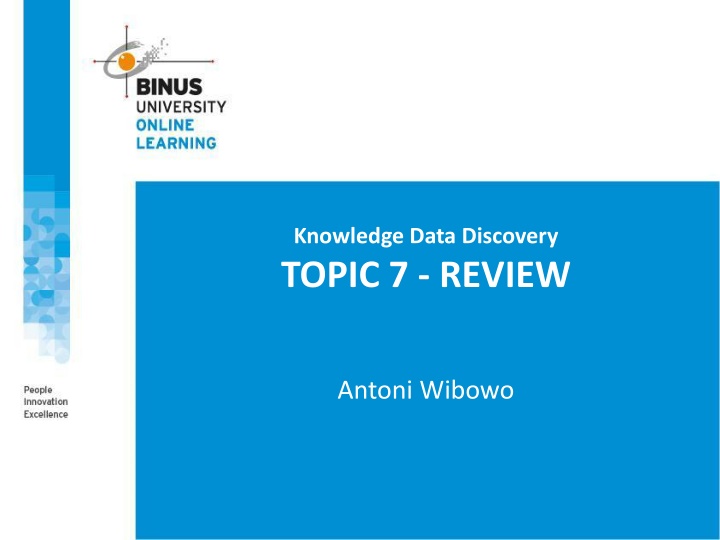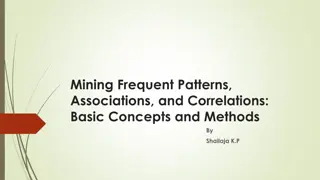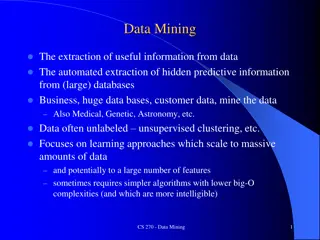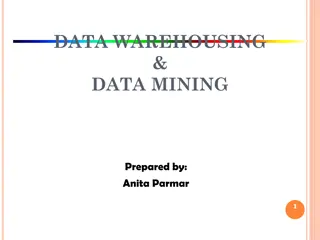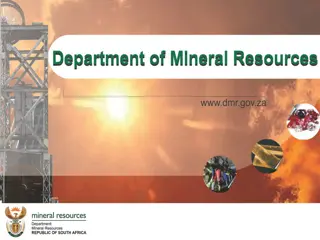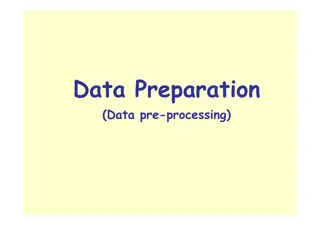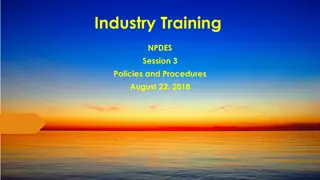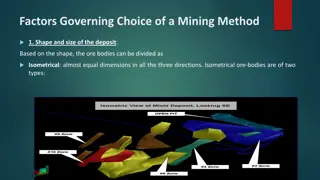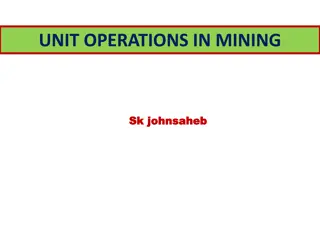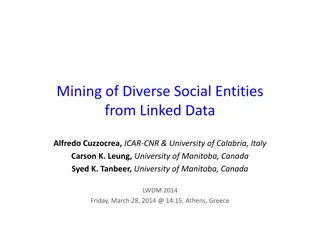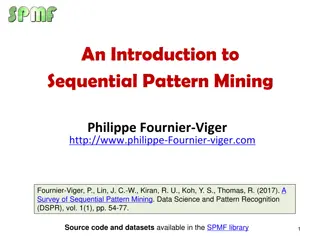Data Mining: Key Concepts and Applications
Data mining involves extracting valuable insights and patterns from vast amounts of data. This process includes data cleaning, integration, selection, transformation, mining, pattern evaluation, and knowledge presentation. The applications of data mining are diverse, ranging from market analysis and customer relationship management to risk analysis, fraud detection, and text mining.
Download Presentation

Please find below an Image/Link to download the presentation.
The content on the website is provided AS IS for your information and personal use only. It may not be sold, licensed, or shared on other websites without obtaining consent from the author.If you encounter any issues during the download, it is possible that the publisher has removed the file from their server.
You are allowed to download the files provided on this website for personal or commercial use, subject to the condition that they are used lawfully. All files are the property of their respective owners.
The content on the website is provided AS IS for your information and personal use only. It may not be sold, licensed, or shared on other websites without obtaining consent from the author.
E N D
Presentation Transcript
Knowledge Data Discovery TOPIC 7 - REVIEW Antoni Wibowo
COURSE OUTLINE 1. PRINCIPLE IN DATA MINING 2. EXPLORING DATA 3. DATA MINING TOOLS 4. DATA PREPROCESSING 5. DATA WAREHOUSE AND OLAP 6. ASSOCIATION ANALYSIS
Note: This slides are based on the additional material provided with the textbook that we use: J. Han, M. Kamber and J. Pei, Data Mining: Concepts and Techniques and P. Tan, M. Steinbach, and V. Kumar "Introduction to Data Mining .
Why Data Mining? The explosive growth of data from terabytes to petabytes Data collection and data availability Automated data collection tools, database systems, Web, computerized society Major sources of abundant data Business: Web, e-commerce, transactions, stocks, Science: Remote sensing, bioinformatics, scientific simulation, Society and everyone: news, digital cameras, YouTube We are drowning in data, but starving for knowledge! Necessity is the mother of invention Data mining Automated analysis of massive data sets 4 August 21, 2024 Introduction
What Is Data Mining? Data mining (knowledge discovery from data) Extraction of interesting (non-trivial, implicit, previously unknown and potentially useful) patterns or knowledge from huge amount of data Alternative names Knowledge discovery (mining) in databases (KDD), knowledge extraction, data/pattern analysis, data archeology, data dredging, information harvesting, business intelligence, etc. Watch out: Is everything data mining ? Simple search and query processing (Deductive) expert systems 5 August 21, 2024 Introduction
Knowledge Discovery Process A KDD process includes data cleaning, data integration, data selection, transformation, data mining, pattern evaluation, and knowledge presentation 8/21/2024 Introduction 6
Applications Data analysis and decision support Market analysis and management Target marketing, customer relationship management (CRM), market basket analysis, cross selling, market segmentation Risk analysis and management Forecasting, customer retention, improved underwriting, quality control, competitive analysis Fraud detection and detection of unusual patterns (outliers) Other Applications Text mining (news group, email, documents) and Web mining Stream data mining (cctv, etc.) Bioinformatics and bio-data analysis 7 August 21, 2024 Introduction
Data mining functionalities? characterization, discrimination, Mining frequent patterns, association, classification, clustering, Outlier,
What is Data? Attributes Collection of data objects and their attributes Tid Refund Marital Taxable Income Cheat Status An attribute is a property or characteristic of an object Examples: eye color of a person, temperature, etc. Attribute is also known as variable, field, characteristic, or feature A collection of attributes describe an object Object is also known as record, point, case, sample, entity, or instance 1 Yes Single 125K No 2 No Married 100K No 3 No Single 70K No 4 Yes Married 120K No 5 No Divorced 95K Yes 6 No Married 60K No Objects 7 Yes Divorced 220K No 8 No Single 85K Yes 9 No Married 75K No 10 No Single 90K Yes 10 8/21/2024 Exploring Data 9
Types of Attributes There are different types of attributes CATEGORICAL Nominal Examples: ID numbers, eye color, zip codes Ordinal Examples: rankings (e.g., taste of potato chips on a scale from 1-10), height in {tall, medium, short}, professional rank {assistant, associate, professor} NUMERIC Numeric: Interval Examples: calendar dates Numeric: Ratio Examples: monetary quantities, counts, age, mass, length, electrical current 8/21/2024 Exploring Data 10
Mining Data Descriptive Characteristics Motivation To better understand the data: central tendency, data dispersion Central tendency characteristics mean, median, and mode Data dispersion characteristics quartiles, interquartile range (IQR), and variance Dispersion Central tendency 8/21/2024 Exploring Data 11
Measuring the Central Tendency 1 n x = i = = x ix Mean (algebraic measure) (sample vs. population): n N n n 1 x = / wixi wi Weighted arithmetic mean: i=1 i=1 Trimmed mean: chopping extreme values Median: A holistic measure Middle value if odd number of values, or average of the middle two values otherwise Estimated by interpolation (for grouped data): / 2 ( ) n f l = + ( ) median L c Mode 1 f median Value that occurs most frequently in the data Unimodal, bimodal, trimodal Empirical formula (unimodal) : = 3 ( ) mean mode mean median 8/21/2024 Exploring Data 12
Most Popular DM Tools The top 10 tools by share of users were (Kdnuggets-2014) Source: http://www.kdnuggets.com Most popular open source tools: RapidMiner, 44.2% share (39.2% in 2013) R, 38.5% ( 37.4% in 2013) Python, 19.5% ( 13.3% in 2013) Weka, 17.0% ( 14.3% in 2013) KNIME, 15.0% ( 5.9% in 2013) Most popular commercial tools: SAS Enterprise Miner MATLAB IBM SPSS Modeler
Popular Open Source DM Tools RapidMiner: many DM algorithms (also can import Weka s methods), extendable, steady learning curve, recent problems with licensing Weka: many DM algorithms, user-friendly, extendable, not the best choice for data visualization or advanced DM tasks at this time R: strong in statistics and DM algorithms, extendable, fast implementations, complexity of extensions, not user-friendly some improvement with Rattle GUI KNIME: user-friendly, extendable (e.g. Weka, R), covers most of the advanced DM tasks as add-ons, no significant downsides Orange: user-friendly, visually appealing GUI, moderate DM algorithms coverage, doesn t cover advanced DM tasks at this time scikit-learn: great documentation, fast implementations, moderate DM algorithms coverage, not user-friendy 14/10
Programming/statistics Language Top ten of programming/ statistics languages used for an analytics/data mining/data science work in 2014: R SAS Python Java Unix Pig Latin/Hive/Hadoop SPSS Matlab Source: http://www.kdnuggets.com
Comparing DM Tools Characteristic RapidMiner R Weka Orange KNIME scikit-learn Univ. of Waikato, New Zealand Univ. of Ljubljana, Slovenia multiple; support: INRIA, Google RapidMiner, Germany worldwide development KNIME.com AG,Switzerland Developer: Programming language: C++, Python, Qt framew. Python+NumPy+ SciPy+matplotlib Java C, Fortran, R Java Java open s. (v.5 or lower); closed s., free Starter ed. (v.6) free software, GNU GPL 2+ open source, GNU GPL 3 open source, GNU GPL 3 open source, GNU GPL 3 License: FreeBSD both; (GUI for DM = Rattle) sci. computation and statistics GUI/CL: GUI both both GUI command line machine learning package add-on Main purpose: general data mining general data mining general data mining general data mining large (~200 000 users) moderate (~ 15 000 users) Community support (est.): very large (~ 2 M users) large moderate moderate 16/10
Why Data Preprocessing? Data in the real world is dirty Incomplete: lacking attribute e.g., occupation= Noisy: containing errors or outliers e.g., Salary= -10 Inconsistent: containing discrepancies in codes or names e.g., Age= 42 Birthday= 03/07/1997 e.g., Was rating 1,2,3 , now rating A, B, C e.g., discrepancy between duplicate records August 21, 2024 Data Preprocessing 17
Why is Data Dirty? Incomplete data may come from Not applicable data value when collected Different considerations between the time when the data was collected and when it is analyzed*) Human/hardware/software problems Noisy data (incorrect values) may come from Faulty data collection instruments Human or computer error at data entry Errors in data transmission Inconsistent data may come from Different data sources Functional dependency violation (e.g., modify some linked data) **) Duplicate records also need data cleaning August 21, 2024 Data Preprocessing 18
Why is Data Preprocessing Important? No quality data, no quality mining results! Quality decisions must be based on quality data e.g., duplicate or missing data may cause incorrect or even misleading statistics. Data warehouse needs consistent integration of quality data Data extraction, cleaning, and transformation comprises the majority of the work of building a data warehouse (up to 90%) August 21, 2024 Data Preprocessing 19
Multi-Dimensional Measure of Data Quality A well-accepted multidimensional view: Accuracy Completeness Consistency Timeliness Believability Non-redudancy Relevance Interpretability Accessibility August 21, 2024 Data Preprocessing 20
Major Tasks in Data Preprocessing Data cleaning Fill in missing values, smooth noisy data, identify or remove outliers, and resolve inconsistencies Data integration Integration of multiple databases, data cubes, or files Data transformation Normalization and aggregation Data reduction Obtains reduced representation in volume but produces the same or similar analytical results Data discretization Part of data reduction but with particular importance, especially for numerical data August 21, 2024 Data Preprocessing 21
What is Data Warehouse? Defined in many different ways, but not rigorously. A decision support database that is maintained separately from the organization s operational database Support information processing by providing a solid platform of consolidated, historical data for analysis. A data warehouse is a subject-oriented, integrated, time-variant, and nonvolatile collection of data in support of management s decision-making process. W. H. Inmon Data warehousing: The process of constructing and using data warehouses Data Warehousing, Data Generalization, and Online Analytical Processing August 21, 2024 22
Data Warehouse vs. Heterogeneous DBMS Data warehouse: update-driven, high performance Traditional heterogeneous DB integration: A query driven approach Information from heterogeneous sources is integrated in advance and stored in warehouses for direct query and analysis Build wrappers/mediators on top of heterogeneous databases A meta-dictionary is used to translate the query into queries and the results are integrated into a global answer set Complex information filtering, compete for resources Data Warehousing, Data Generalization, and Online Analytical Processing August 21, 2024 23
Data Warehouse vs. Heterogeneous DBMS OLTP (on-line transaction processing) Major task of traditional relational DBMS Day-to-day operations: purchasing, inventory, banking, manufacturing, payroll, registration, accounting, etc. OLAP (on-line analytical processing) Major task of data warehouse system Data analysis and decision making Distinct features (OLTP vs. OLAP): User and system orientation: customer vs. market Data contents: current, detailed vs. historical, consolidated Database design: ER + application vs. star + subject View: current, local vs. evolutionary, integrated Access patterns: update vs. read-only but complex queries Data Warehousing, Data Generalization, and Online Analytical Processing August 21, 2024 24
Typical OLAP Operations Roll up (drill-up): summarize data by climbing up hierarchy or by dimension reduction Drill down (roll down): reverse of roll-up from higher level summary to lower level summary or detailed data, or introducing new dimensions Slice and dice: project and select Pivot (rotate): reorient the cube, visualization, 3D to series of 2D planes Other operations drill across: involving (across) more than one fact table drill through: through the bottom level of the cube to its back-end relational tables (using SQL) Data Warehousing, Data Generalization, and Online Analytical Processing August 21, 2024 25
Market Basket Analysis Mining Frequent Patterns, Association, and Correlations General data characteristics 8/21/2024 26
Why Is Freq. Pattern Mining Important? Discloses an intrinsic and important property of data sets Forms the foundation for many essential data mining tasks Association, correlation, and causality analysis Sequential, structural (e.g., sub-graph) patterns Pattern analysis in spatiotemporal, multimedia, time-series, and stream data Classification: associative classification Cluster analysis: frequent pattern-based clustering Data warehousing: iceberg cube and cube-gradient Broad applications Mining Frequent Patterns, Apriori Method, Frequent Pattern (FP) Growth Method 8/21/2024 27
Basic Concepts: Frequent Patterns and Association Rules Itemset X = {x1, , xk} Find all the rules X Y with minimum support and confidence support, s, probability that a transaction contains X Y confidence, c, conditional probability that a transaction having X also contains Y Transaction-id Items bought 10 A, B, D 20 A, C, D 30 A, D, E 40 B, E, F 50 B, C, D, E, F Customer buys both Customer buys diaper Let sup_min = 50%, con_fmin = 50% Freq. Pat.: {A:3, B:3, D:4, E:3, AD:3} Association rules: A => D (sup=60%, conf=100%) D => A (sup=60%, conf=75%) Customer buys beer
Summary We have briefly reviewed the fundamental of the materials of Principle in Data Mining Exploring DATA DATA MINING TOOLS DATA PREPROCESSING DATA WAREHOUSE AND OLAP ASSOCIATION ANALYSIS 29 August 21, 2024 Introduction
References 1. Han, J., Kamber, M., & Pei, Y. (2006). Data Mining: Concepts and Technique . Edisi 3. Morgan Kaufman. San Francisco 2. Tan, P.N., Steinbach, M., & Kumar, V. (2006). Introduction to Data Mining . Addison-Wesley. Michigan 3. Witten, I. H., & Frank, E. (2005). Data Mining : Practical Machine Learning Tools and Techniques . Second edition. Morgan Kaufmann. San Francisco 8/21/2024 Introduction 30
Thank You Thank You
